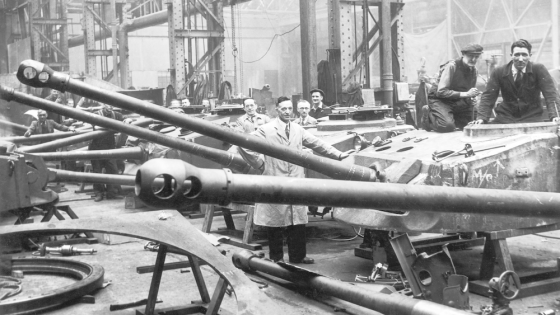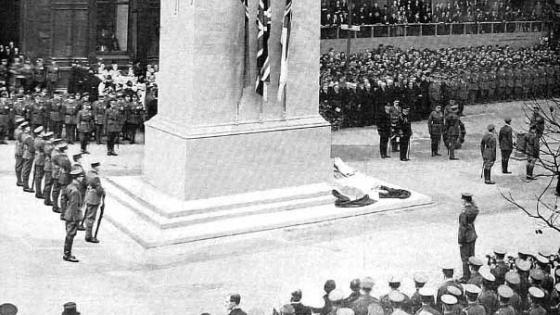In May 2020 we mark the 75th anniversary of Victory in Europe, with Victory over Japan to follow in September. In WWII, the insurgent powers of the Axis set out to change the international order in their favour (Mawdsley 2020). The world did change, although not as they expected. The process touched the lives of every family on five continents.
WWII was the greatest conflict of an era of mass warfare. Both the world wars required a vast mobilization of productive effort. Mobilization for the Second World War was more extensive than for the First. WWI was fought on land in Europe and the Near East and at sea in the Atlantic, while WWII was expanded to Asia and the Pacific and to the air. While the major economies mobilised 30% to 60% of their national incomes for WWI, WWII demanded 50% to 70%. Both wars reached the limit of what was sustainable for a modern economy at the time. The human losses were also greater: more than 50 million in WWII compared with 20 million or more in WWI (Harrison 1998, Broadberry and Harrison 2005); this omits the death toll from the flu pandemic of 1918/19, which may have been of similar size.
Economics – and economists – were everywhere in WWII. Economic considerations motivated the war. The war was managed with the help of economics. Economic factors powerfully influenced its outcome. There were profound and persistent economic consequences.
Download the VoxEU eBook, The Economics of the Second World War: Seventy-Five Years On, here
The idea of the new VoxEU eBook, The Economics of the Second World War: Seventy-Five Years On (Broadberry and Harrison 2020), arose as a sequel to the essays we collected for the centenary of the end of WWI (Broadberry and Harrison 2018). Our chapters are again divided into three main parts. These cover, respectively, the origins, waging, and consequences of WWII.
Preparations for war
In this section, Hans-Joachim Voth examines the roots of Hitler’s war in the Great Depression, showing how the Nazis won electoral support by tapping into local exposure to fiscal austerity and bank collapses. Richard Overy shows that German war preparations were comprehensive; the low level and slow growth of war production in the early stages of the war are explained better by various kinds of inefficiency than by intention. Mark Harrison turns attention to Soviet war preparations, which began long before any real prospect of war and became nearly all-consuming; while effective, they were neither efficient nor humane. British war mobilisation for WWII benefited by learning from experience of WWI, but Stephen Broadberry argues that the British mobilisation also gained from the advantages of a strong liberal market economy and representative democracy – a lesson too often neglected.
Conduct of the war
Several chapters in this section consider war production. Phillips O’Brien argues that the process that decided victory and defeat in WWII was the production and attrition of ships and planes. It was in the war on the ground that most soldiers fought and died, but it was air and sea power that decided what battles would be fought. David Edgerton continues this theme, showing that Britain did not stand alone and undefended in 1940, but derived great strengths from its foreign economic relations, defended by air and sea power. Price Fishback shows how the US economy then became the ‘arsenal of democracy’, sacrificing much more consumption than is commonly recognised for the sake of war production and services. In WWII, each side targeted the war production and consumption of the adversary through economic warfare. Mark Harrison discusses the insights of the economist Mançur Olson into why economic warfare worked or (more often) failed. Tetsuji Okazaki examines the war production success and eventual failure of Mitsubishi Heavy Industries in Japan. The company’s strength was its network of subcontractors, but this network was finally destroyed by Allied bombing and the Tōnankai earthquake.
Hein Klemann turns to the tragic fate of occupied economies. German exploitation was more effective in Western Europe; its consequences were terrible everywhere, but worse in the East. Eric Golson discusses the economics of Europe’s few neutral nations. Neutrality, he argues, was not a matter of maintaining impartiality, but of continuous renegotiation with belligerent neighbours to avoid capture by either side. Finally, economists and economically minded politicians played a much greater role in WWII than in previous conflicts, and Alan Bollard discusses their contributions.
Consequences of the war
Our final section considers consequences of the war. Cormac O Grada enumerates famine deaths, finding a total of 20 to 25 million – as many as died of violence. Another consequence was a sharp reduction of inequality in the rich market economies; Walter Scheidel shows how this happened and how far it went. Tamas Vonyo describes the process of European economic recovery from the war, which was rapid everywhere but impeded in Eastern Europe by the demographic disaster that had taken place there. Finally, Pauline Grosjean examines the persistent influence of the war on our views of the state, and of each other. She finds evidence that those whose families suffered most still show lower social and political trust today.
Concluding remarks
The Second World War was the greatest conflict of an era of mass warfare. When was that era? Onorato et al. (2014) suggest that it was inaugurated by a transport innovation, the first use of railways to concentrate and deploy a mass army of a hundred thousand men in the Second Italian War of Independence of 1859, followed closely by the larger mobilisations of the American Civil War. Thereafter railways dominated the logistics of the great land offensives of the two World Wars. The era ended in the 1970s, Onorato et al. maintain, with the advent of another transport innovation, the precision-guided nuclear-capable cruise missile. This took away the point of mass armies by converting them from instruments to sitting targets.
If the era of mass warfare is truly over, then the lessons of the Second World War, like those of the First, should belong to another world that is no longer ours. Given this, we are surprised by the continuing relevance and salience of the lessons that our authors point to.
Writing in the early months of the 2020 coronavirus pandemic, it’s clear to us that our world continues to experience episodes that remind us of the profound disruptions of 20th-century wartime. The public interest suddenly requires the limitation of normal work and leisure. Government directives demand that everyone plays their part. Corporate strategies, family plans, and personal goals are suddenly upended. Each citizen must rebalance personal ambition, family attachments, and the claims of society. There are casualties and losses. Some make sacrifices, while others are sacrificed.
Under these circumstances, it seems that it might be useful to know a few things about what happened and how it worked out the last time our society was engulfed by an all-consuming emergency.
References
Broadberry, S, and M Harrison (2005), “The economics of World War I: an overview,” in S Broadberry and M Harrison (eds), The economics of World War I, pp. 1-30, Cambridge University Press.
Broadberry, S, and M Harrison (eds) (2018). The Economics of the Great War: A Centennial Perspective, CEPR, Press.
Broadberry, S, and M Harrison (eds) (2020). The Economics of the Second World War: Seventy-Five Years On, CEPR, Press.
Harrison, M (1998), “Economic mobilization for World War II: an overview,” in M Harrison (ed). The economics of World War II: Six great powers in international comparison, pp. 1-42, Cambridge University Press.
Mawdsley, E (2020), World War II: A new history, 2nd edition, Cambridge University Press.
Onorato, M G, K Scheve, and D Stasavage (2014), “Technology and the era of the mass army,” Journal of Economic History 74(2): 449-481.



